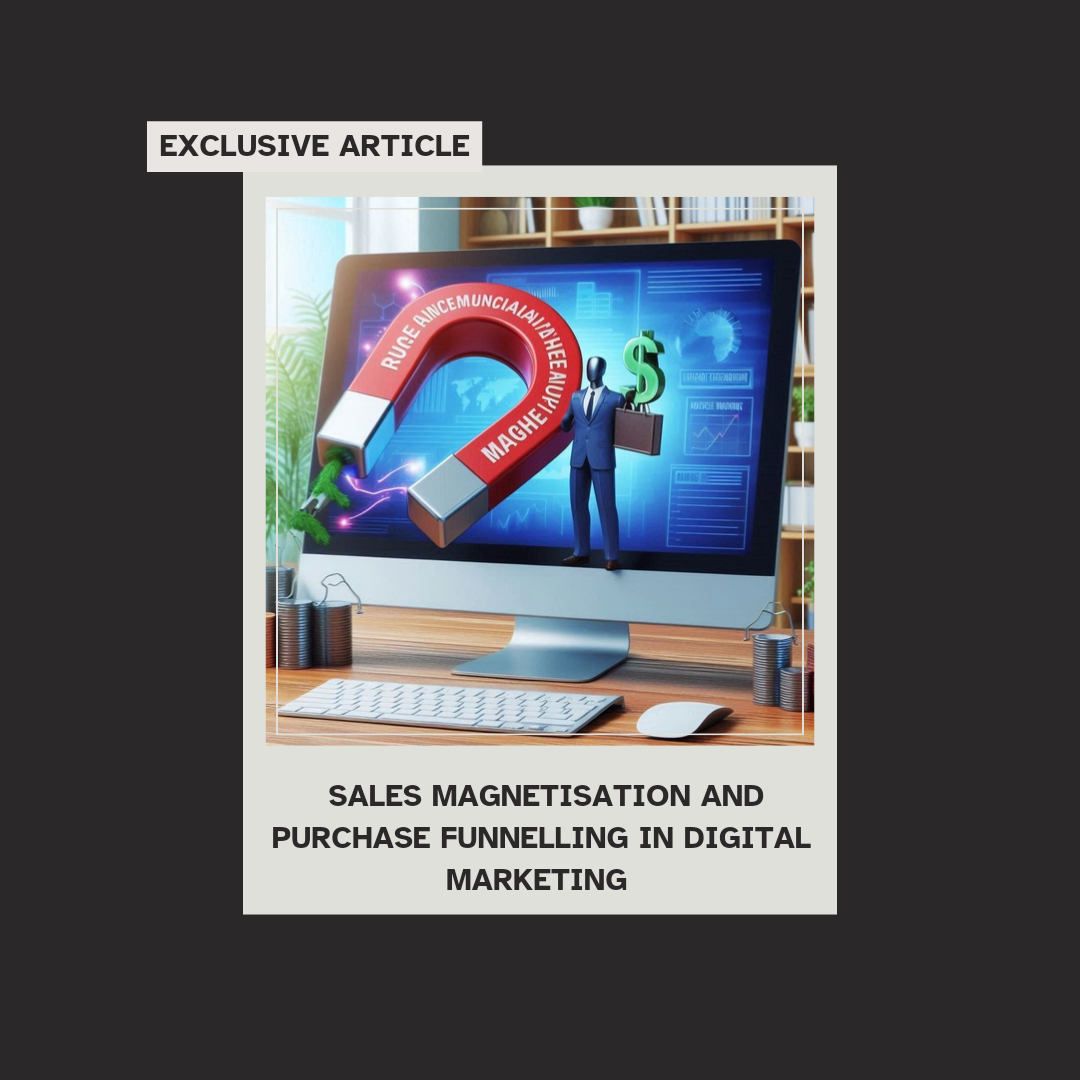Articles
Business and the Economy
EXCLUSIVE
ARTICLES
Make an impact today
Support my free content by contributing a donation.

The Impact of Sustained Economic Growth, Business Expansion, and Discretionary Marketing in an Online Enterprise
Sustained economic growth plays a pivotal role in shaping the landscape of online enterprises. When an economy is prospering, disposable income rises, leading to increased consumer spending. This shift enables online businesses to expand their operations, diversify their offerings, and invest in marketing strategies that leverage the heightened purchasing power of consumers.
In an environment characterised by sustained economic growth, businesses are often encouraged to scale their operations. This may involve expanding product lines, exploring new markets, or enhancing technological capabilities. For online enterprises, these expansions allow them to meet the growing demands of a more affluent customer base, positioning themselves as competitive players in a crowded marketplace.
Furthermore, the concept of discretionary marketing becomes increasingly significant during periods of economic prosperity. With more funds available for marketing initiatives, businesses are empowered to adopt innovative digital strategies, such as influencer collaborations, targeted social media campaigns, and advanced data analytics. This enables them to engage with consumers in a more personalised manner, enhancing brand loyalty and driving repeat sales.
However, it is crucial for businesses to approach expansion and marketing with a strategic mindset. While growth can provide opportunities, it also carries risks, including overextension and market saturation. Thus, careful analysis and planning are essential to ensure that the benefits of sustained economic growth are maximised without compromising the integrity of the online enterprise. The interplay of these factors underscores the importance of a rigorous approach to management and a keen understanding of market dynamics as businesses navigate the evolving economic landscape.
Sustained economic growth plays a pivotal role in shaping the landscape of online enterprises. When an economy is prospering, disposable income rises, leading to increased consumer spending. This shift enables online businesses to expand their operations, diversify their offerings, and invest in marketing strategies that leverage the heightened purchasing power of consumers.
In an environment characterised by sustained economic growth, businesses are often encouraged to scale their operations. This may involve expanding product lines, exploring new markets, or enhancing technological capabilities. For online enterprises, these expansions allow them to meet the growing demands of a more affluent customer base, positioning themselves as competitive players in a crowded marketplace.
Furthermore, the concept of discretionary marketing becomes increasingly significant during periods of economic prosperity. With more funds available for marketing initiatives, businesses are empowered to adopt innovative digital strategies, such as influencer collaborations, targeted social media campaigns, and advanced data analytics. This enables them to engage with consumers in a more personalised manner, enhancing brand loyalty and driving repeat sales.
However, it is crucial for businesses to approach expansion and marketing with a strategic mindset. While growth can provide opportunities, it also carries risks, including overextension and market saturation. Thus, careful analysis and planning are essential to ensure that the benefits of sustained economic growth are maximised without compromising the integrity of the online enterprise. The interplay of these factors underscores the importance of a rigorous approach to management and a keen understanding of market dynamics as businesses navigate

How To Optimize and Identify Behavioral Changes and Industrial Trends in Online Marketing
In the evolving landscape of online marketing, understanding and optimizing behavioral changes and industrial trends is critical for businesses aiming to maintain competitive advantage. A systematic approach to identifying these behavioral shifts begins with robust data analytics. Utilizing tools such as Google Analytics, social media insights, and customer feedback can provide invaluable information on user interactions and preferences.
Businesses should focus on analyzing engagement metrics, such as click-through rates and time spent on site, to detect subtle changes in consumer behavior. Segmenting audiences based on demographics, purchasing patterns, and engagement levels allows marketers to tailor their strategies accordingly.
Simultaneously, staying attuned to industry trends, such as shifts towards sustainability or increased demand for personalized marketing, is essential. Regularly reviewing market research reports and competitor analysis can help identify these trends early. Engaging in continuous learning through webinars, industry conferences, and networking with peers enables marketers to remain agile in a rapidly changing environment.
Implementing A/B testing for marketing campaigns fosters a culture of experimentation. Marketers can compare different versions of content or ads to determine which resonates better with their audience. This iterative process not only refines current strategies but also uncovers potential emerging trends dictated by consumer preferences.
Finally, leveraging customer relationship management (CRM) systems can enhance a company’s ability to predict behavioral changes through the analysis of historical data. By integrating insights gathered from various touchpoints, businesses can create a holistic view of the customer journey, enabling them to adapt and optimize their marketing efforts proactively.
In summary, the successful optimization and identification of behavioral changes and industrial trends in online marketing hinges on a combination of data analysis, industry research, audience segmentation, and a willingness to iterate and innovate based on real-time feedback and performance
In the evolving landscape of online marketing, understanding and optimizing behavioral changes and industrial trends is critical for businesses aiming to maintain competitive advantage. A systematic approach to identifying these behavioral shifts begins with robust data analytics. Utilizing tools such as Google Analytics, social media insights, and customer feedback can provide invaluable information on user interactions and preferences.
Businesses should focus on analyzing engagement metrics, such as click-through rates and time spent on site, to detect subtle changes in consumer behavior. Segmenting audiences based on demographics, purchasing patterns, and engagement levels allows marketers to tailor their strategies accordingly.
Simultaneously, staying attuned to industry trends, such as shifts towards sustainability or increased demand for personalized marketing, is essential. Regularly reviewing market research reports and competitor analysis can help identify these trends early. Engaging in continuous learning through webinars, industry conferences, and networking with peers enables marketers to remain agile in a rapidly changing environment.
Implementing A/B testing for marketing campaigns fosters a culture of experimentation. Marketers can compare different versions of content or ads to determine which resonates better with their audience. This iterative process not only refines current strategies but also uncovers potential emerging trends dictated by consumer preferences.
Finally, leveraging customer relationship management (CRM) systems can enhance a company’s ability to predict behavioural changes through the analysis of historical data. By integrating insights gathered from various touchpoints, businesses can create a holistic view of the customer journey, enabling them to adapt and optimize their marketing efforts proactively.
In summary, the successful optimization and identification of behavioral changes and industrial trends in online marketing hinges on a combination of data analysis, industry research, audience segmentation, and a willingness to iterate and innovate based on real-time feedback and performance metrics.

Impact of Inflation on Consumer Pricing Index (CPI) in Online Business
Inflation significantly influences the Consumer Pricing Index (CPI), which serves as a crucial metric for online businesses in understanding price fluctuations and consumer purchasing power. As inflation rises, the cost of goods and services increases, directly affecting the prices listed by online retailers. This shift can lead to a more elastic demand curve, where consumers become more sensitive to price changes, prompting businesses to reassess their pricing strategies.
In online sectors, the immediate response to CPI changes may involve adjusting product prices or offering promotional discounts to combat potential losses in sales volume. Higher inflation can erode disposable income, thereby altering consumer behaviour, as shoppers may prioritise essential goods over luxury items. Businesses must remain vigilant, analysing CPI trends to anticipate consumer sentiment and adapt accordingly.
Furthermore, inflation can impact operational costs, from logistics to marketing expenses, necessitating a comprehensive approach to pricing that balances competitiveness with profitability. To mitigate these challenges, online businesses may adopt strategies such as dynamic pricing, leveraging data analytics to adjust prices in real time based on market conditions and consumer behaviour. The interplay between inflation and CPI is a critical factor that online businesses must navigate to sustain growth and customer loyalty in an increasingly volatile economic landscape.

How to Plan and Execute Content Differentiation in 2024
In the rapidly evolving digital landscape of 2024, content differentiation is essential for businesses aiming to capture and retain their target audience. Here are key strategies to effectively plan and execute a content differentiation strategy:
Identify Your Unique Value Proposition (UVP)
Begin by clearly defining what sets your content apart from competitors. This could involve offering unique insights, presenting data in innovative ways, or addressing niche topics that matter to your audience. Conduct thorough market research to understand competitors and identify gaps that your content can fill.Segment Your Audience
Understanding your audience segments is critical. Use demographic, psychographic, and behavioural data to segment your audience effectively. Tailor content specifically for each segment, ensuring it resonates with their unique interests and needs. [Consider using tools like surveys and social media analytics for deeper insights.]Leverage Diverse Content Formats
Diversifying the format of your content can significantly enhance differentiation. Experiment with articles, infographics, videos, podcasts, and interactive content. Each format can provide a fresh perspective and engage different segments of your audience. For instance, while millennials may prefer video content, older demographics might lean more towards in-depth articles.Emphasise Storytelling
In 2024, storytelling remains one of the most powerful tools for content differentiation. Share authentic stories that connect emotionally with your audience. Highlight customer experiences, case studies, and behind-the-scenes insights that humanise your brand. Engage your audience by making them a part of your narrative.Focus on Quality over Quantity
With an abundance of content available, quality has never been more important. Aim for high-value content that provides real insights, solutions, or entertainment. Invest in skilled writers, content creators, and graphic designers to ensure your output is polished and professional.Utilise Data-Driven Insights
Incorporate analytics into your content strategy to continually measure engagement and effectiveness. Use tools to track performance metrics such as click-through rates, time spent on page, and social shares. Adapt your approach based on data-driven insights to refine your content and maintain its relevance.Integrate User-Generated Content (UGC)
Encourage your audience to contribute content related to your brand. User-generated content not only provides authenticity but also fosters community engagement. Showcase UGC through social media platforms and incorporate it into your broader content strategy to enhance relatability and trust.Monitor Trends and Adapt
Stay agile by continuously monitoring industry trends, consumer preferences, and technological advancements. Subscribe to relevant publications, participate in webinars, and engage with thought leaders in your niche. Being ahead of trends allows you to pivot your content strategy effectively, ensuring it remains fresh and engaging.
Executing a content differentiation strategy in 2024 demands a proactive and flexible approach. By focusing on originality, quality, and audience engagement, businesses can significantly enhance their market presence and drive sustainable growth.
Planning and Executing Content Differentiation in 2024
In the rapidly evolving digital landscape of 2024, content differentiation is essential for businesses aiming to capture and retain their target audience. Here are key strategies to effectively plan and execute a content differentiation strategy:
Identify Your Unique Value Proposition (UVP)
Begin by clearly defining what sets your content apart from competitors. This could involve offering unique insights, presenting data in innovative ways, or addressing niche topics that matter to your audience. Conduct thorough market research to understand competitors and identify gaps that your content can fill.Segment Your Audience
Understanding your audience segments is critical. Use demographic, psychographic, and behavioural data to segment your audience effectively. Tailor content specifically for each segment, ensuring it resonates with their unique interests and needs. [Consider using tools like surveys and social media analytics for deeper insights.]Leverage Diverse Content Formats
Diversifying the format of your content can significantly enhance differentiation. Experiment with articles, infographics, videos, podcasts, and interactive content. Each format can provide a fresh perspective and engage different segments of your audience. For instance, while millennials may prefer video content, older demographics might lean more towards in-depth articles.Emphasise Storytelling
In 2024, storytelling remains one of the most powerful tools for content differentiation. Share authentic stories that connect emotionally with your audience. Highlight customer experiences, case studies, and behind-the-scenes insights that humanise your brand. Engage your audience by making them a part of your narrative.Focus on Quality over Quantity
With an abundance of content available, quality has never been more important. Aim for high-value content that provides real insights, solutions, or entertainment. Invest in skilled writers, content creators, and graphic designers to ensure your output is polished and professional.Utilise Data-Driven Insights
Incorporate analytics into your content strategy to continually measure engagement and effectiveness. Use tools to track performance metrics such as click-through rates, time spent on page, and social shares. Adapt your approach based on data-driven insights to refine your content and maintain its relevance.Integrate User-Generated Content (UGC)
Encourage your audience to contribute content related to your brand. User-generated content not only provides authenticity but also fosters community engagement. Showcase UGC through social media platforms and incorporate it into your broader content strategy to enhance relatability and trust.Monitor Trends and Adapt
Stay agile by continuously monitoring industry trends, consumer preferences, and technological advancements. Subscribe to relevant publications, participate in webinars, and engage with thought leaders in your niche. Being ahead of trends allows you to pivot your content strategy effectively, ensuring it remains fresh and engaging.

How To Identify Your Unique Market Proposition
Identifying your unique market proposition (UMP) is essential for distinguishing your business in a competitive landscape. Begin by conducting thorough market research to understand your target audience's needs, preferences, and pain points. Identify gaps in the market that your competitors may not be addressing.
Next, analyse your strengths and weaknesses in relation to those opportunities. Consider what sets your product or service apart—is it superior quality, innovative features, exceptional customer service, or perhaps competitive pricing?
Engage in direct conversations with your customers to gain insights into what they value most about your offerings. This feedback can illuminate areas in which you excel or where you can improve.
Additionally, evaluate your brand’s mission and core values. Your UMP should resonate not only with your audience but also align with your business philosophy.
Once you have gathered this information, craft a clear and concise statement that encapsulates your UMP. This statement should communicate the unique benefits your business provides and why customers should choose you over the competition. Remember, clarity and relevance
Identifying your unique market proposition (UMP) is essential for distinguishing your business in a competitive landscape. Begin by conducting thorough market research to understand your target audience's needs, preferences, and pain points. Identify gaps in the market that your competitors may not be addressing.
Next, analyse your strengths and weaknesses in relation to those opportunities. Consider what sets your product or service apart—is it superior quality, innovative features, exceptional customer service, or perhaps competitive pricing?
Engage in direct conversations with your customers to gain insights into what they value most about your offerings. This feedback can illuminate areas in which you excel or where you can improve.
Additionally, evaluate your brand’s mission and core values. Your UMP should resonate not only with your audience but also align with your business philosophy.
Once you have gathered this information, craft a clear and concise statement that encapsulates your UMP. This statement should communicate the unique benefits your business provides and why customers should choose you over the competition. Remember, clarity and relevance are key to effectively conveying your distinct position in the market.

How Aggregate Supply and Demand Reflects The Market Deficit of an Online Business
In the context of online businesses, aggregate supply and demand play pivotal roles in determining market equilibrium and subsequently the presence of market deficits. Aggregate supply represents the total output of goods and services that online businesses are willing to produce at various price levels, while aggregate demand reflects the total quantity of products that consumers are willing to purchase.
When an online business experiences a market deficit, it occurs when aggregate demand exceeds aggregate supply. This imbalance may stem from various factors, such as rapid shifts in consumer preferences, seasonal trends, or insufficient product availability. For instance, if a popular online retailer fails to anticipate a surge in demand for a newly launched product, it may quickly find itself unable to meet customer expectations. This inadequacy not only erodes customer trust but can also lead to lost sales opportunities.
Moreover, market deficits in an online business can signal underlying issues such as supply chain constraints or inefficiencies in inventory management. For example, disruptions caused by logistical challenges or increased shipping times can impede an online business's ability to provide adequate supply. Consequently, it becomes essential for these businesses to adopt real-time analytics and demand forecasting tools to maintain a more accurate alignment between supply and demand.
Understanding the dynamics of aggregate supply and demand allows online businesses to adapt their strategies effectively. By leveraging data-driven insights, businesses can optimize their operational processes, ensuring that they not only meet existing consumer demand but also anticipate shifts that may arise in the marketplace. Additionally, implementing flexible pricing strategies can help mitigate the impacts of supply shortages, thereby stabilizing revenues during periods of heightened demand.
Ultimately, awareness of aggregate supply and demand enables online businesses to navigate market deficits proactively, ensuring sustained growth and competitiveness in an increasingly dynamic digital landscape.

Modern Lead Magnets, Product Discrepancy and Perfect Pricing Completion: Part 2
In today's competitive marketing landscape, understanding the dynamics of modern lead magnets, product discrepancies, and perfect pricing completion part 2 is essential for businesses aiming to enhance customer acquisition and retention.
Modern Lead Magnets
Lead magnets have evolved significantly from the traditional eBooks and whitepapers. Today's lead magnets encompass a diverse range of offerings, such as interactive webinars, free trials, and exclusive access to premium content. The key to an effective lead magnet lies in its ability to provide immediate value while aligning closely with the target audience’s pain points. By leveraging insights from customer behaviour and preferences, businesses can craft lead magnets that not only capture attention but also facilitate a seamless transition into the sales funnel.
Product Discrepancy
Product discrepancy refers to the gap between customer expectations and the actual product experience. This discrepancy can manifest in various forms, including differences in perceived value, quality, and functionality. In an era where consumers are more informed and vocal than ever, businesses must ensure that their offerings consistently meet or exceed expectations. Addressing product discrepancies involves thorough market research, ongoing customer feedback loops, and committing to continuous improvement. Companies that proactively manage this aspect can enhance customer satisfaction, foster brand loyalty, and reduce churn rates.
Perfect Pricing Completion
Achieving perfect pricing completion is about finding the optimal price point that reflects the product’s value while remaining competitive. This involves a comprehensive analysis of market trends, customer willingness to pay, and the perceived value of the product. Businesses need to adopt a dynamic pricing strategy that allows for adjustments based on market feedback and changing consumer sentiment. Additionally, effective communication of pricing benefits can help mitigate potential hesitations from customers, reinforcing the value offered. By perfectly aligning the pricing strategy with customer expectations and market dynamics, businesses can optimize conversions and drive revenue growth.
In conclusion, integrating these elements—modern lead magnets, diligent management of product discrepancies, and perfect pricing completion—will empower businesses to create a compelling value proposition in an ever-evolving marketplace.

How to Reach Your Target Audience in Online Business
Reaching your target audience in online business is crucial for driving engagement, conversions, and long-term success. Here are several strategies to effectively connect with your desired demographic:
Identify Your Target Audience
Before you can reach your audience, you need to clearly define who they are. This involves researching demographics, interests, and purchasing behaviors. Use tools like surveys, social media analytics, and market research reports to gather data. Create detailed buyer personas that encapsulate the traits and motivations of your ideal customers.
Leverage Social Media Platforms
Social media is a powerful tool for reaching your target audience. Each platform caters to different demographics, so choose the ones that align with your audience's preferences. For instance, Instagram is popular with younger audiences, while LinkedIn is favored by professionals. Tailor your content to fit the platform's style and your audience's expectations—whether through engaging visuals on Instagram or informative articles on LinkedIn.
Content Marketing
High-quality content that resonates with your audience can establish authority and build trust. Develop blog posts, videos, infographics, and podcasts that provide value to your target audience. Focus on their pain points and interests. Implement SEO best practices to ensure your content ranks well in search engine results, making it more discoverable to those looking for information in your niche.
Email Marketing
Build an email list to maintain direct communication with your audience. Send personalized content and promotions that speak directly to their needs and interests. Segment your email list based on customer behavior and preferences to increase engagement rates. Regular newsletters can keep your brand at the top of their minds while driving traffic to your website or social media channels.
Paid Advertising
Consider using targeted advertising on platforms like Google Ads and social media. These platforms allow you to define specific demographics, interests, and behaviors to ensure your ads are seen by those most likely to convert. Monitor and analyze the performance of your campaigns, adjusting them based on what works best for your audience.
Collaboration and Networking
Partner with influencers or businesses that share your target audience. This can provide access to a wider audience and build credibility for your brand. Take part in online forums and discussion groups related to your industry to further establish your presence and connect with potential customers.
By combining these strategies and consistently adapting to your audience’s changing preferences, you can effectively reach and engage your target audience in the online business landscape. Understanding and meeting their needs will ultimately lead to increased loyalty and growth for your business.

Modern Lead Magnets, Product Discrepancy and Perfect Pricing Completion: Part 1
In today's competitive marketing landscape, understanding the dynamics of modern lead magnets, product discrepancies, and perfect pricing completion part 1 is essential for businesses aiming to enhance customer acquisition and retention.
Modern Lead Magnets
Lead magnets have evolved significantly from the traditional eBooks and whitepapers. Today's lead magnets encompass a diverse range of offerings, such as interactive webinars, free trials, and exclusive access to premium content. The key to an effective lead magnet lies in its ability to provide immediate value while aligning closely with the target audience’s pain points. By leveraging insights from customer behaviour and preferences, businesses can craft lead magnets that not only capture attention but also facilitate a seamless transition into the sales funnel.
Product Discrepancy
Product discrepancy refers to the gap between customer expectations and the actual product experience. This discrepancy can manifest in various forms, including differences in perceived value, quality, and functionality. In an era where consumers are more informed and vocal than ever, businesses must ensure that their offerings consistently meet or exceed expectations. Addressing product discrepancies involves thorough market research, ongoing customer feedback loops, and committing to continuous improvement. Companies that proactively manage this aspect can enhance customer satisfaction, foster brand loyalty, and reduce churn rates.
Perfect Pricing Completion
Achieving perfect pricing completion is about finding the optimal price point that reflects the product’s value while remaining competitive. This involves a comprehensive analysis of market trends, customer willingness to pay, and the perceived value of the product. Businesses need to adopt a dynamic pricing strategy that allows for adjustments based on market feedback and changing consumer sentiment. Additionally, effective communication of pricing benefits can help mitigate potential hesitations from customers, reinforcing the value offered. By perfectly aligning the pricing strategy with customer expectations and market dynamics, businesses can optimise conversions and drive revenue growth.
In conclusion, integrating these elements—modern lead magnets, diligent management of product discrepancies, and perfect pricing completion—will empower businesses to create a compelling value proposition in an ever-evolving marketplace.

How Sales Magnetisation and Purchase Funnelling Works in Digital Marketing
In the rapidly evolving landscape of digital marketing, the concepts of sales magnetization and purchase funneling play critical roles in converting leads into loyal customers. Sales magnetization refers to the strategic process of attracting potential customers by creating compelling offers, utilising targeted content, and optimising brand visibility. This draws in visitors who are not just browsing but are actively seeking solutions that your product or service provides.
Effective sales magnetization begins with thorough research into your target audience’s preferences and pain points. By developing buyer personas and leveraging data analytics, businesses can tailor their messaging to resonate deeply with prospective customers. This engagement often occurs across multiple platforms, including social media, email marketing, and content marketing, where touchpoints are designed to capture interest and promote interaction.
Once potential customers are drawn in through these initial touchpoints, the process of purchase funneling begins. The purchase funnel is essentially a visual representation of the customer journey from awareness to conversion. It consists of several key stages: awareness, interest, consideration, intent, evaluation, and purchase. Understanding these stages is crucial for marketers, as it allows them to develop targeted strategies for nurturing leads at each step.
At the awareness stage, the focus is on creating brand recognition through informative content, advertisements, and social media engagement. As leads move to the interest stage, they seek deeper insights and evaluations of offerings, making compelling product descriptions and client testimonials vital. In the consideration stage, this could involve more personalised communication, such as email drip campaigns tailored to respond to specific inquiries or behaviours.
The intent stage is pivotal; this is where potential customers are deciding between options. Strategies such as retargeting ads, limited-time offers, and detailed comparisons can be instrumental at this junction. Finally, as prospects reach the evaluation and purchase stages, a seamless transaction experience, alongside follow-up communications, ensures not just a sale but also sets the foundation for future loyalty.
In conclusion, integrating sales magnetization with an effective purchase funnel allows businesses to not only attract potential customers but also guide them through a structured journey, enhancing conversion rates and fostering long-term relationships. This holistic approach is imperative in today’s competitive digital marketplace, ensuring that every step of the customer journey is optimised for maximum engagement and satisfaction.

Conducting Client Analysis for Service Products in a Competitive Market
In today’s dynamic marketplace, understanding your clients is paramount for any business offering service products. Conducting a thorough client analysis involves a comprehensive examination of client needs, preferences, and behaviours to ensure alignment with market offerings. This process not only identifies existing customer segments but also uncovers potential new markets.
1. Defining the Client Profile
Start by creating detailed client personas. These should include demographic information such as age, gender, income level, and geographic location, as well as psychographic factors including interests, values, and lifestyle choices. Understanding who your clients are will aid in tailoring your service products to meet their specific needs.
2. Evaluating Client Needs and Expectations
Conduct surveys, interviews, or focus groups to gather qualitative and quantitative data. This will provide insights into what clients value most in a service product. Questions should uncover pain points and expectations, enabling you to refine your offerings. Consider utilising tools such as Net Promoter Score (NPS) to gauge customer satisfaction and loyalty.
3. Competitive Benchmarking
Analyse competitors in the market. This includes studying their service offerings, pricing strategies, and customer feedback. By understanding how competitors position themselves, you can identify gaps in the market and develop strategies to differentiate your services. This may involve innovating on service delivery, enhancing customer support, or offering unique features that add value for clients.
4. Utilising Data Analytics
Leverage data analytics to gain deeper insights into client behaviour. Tracking online interactions, purchase histories, and engagement patterns can reveal trends and preferences. This data allows for more informed decision-making and the ability to adapt to changing client demands effectively.
5. Developing Client Engagement Strategies
Create targeted marketing and communication strategies that resonate with your client base. Personalisation, through tailored content and offers, is key to fostering engagement. Building a strong relationship with clients not only enhances customer loyalty but also turns them into advocates for your brand.
Conclusion
A robust client analysis serves as the foundation for developing competitive service products. By continually assessing client needs, monitoring market trends, and adjusting strategies accordingly, businesses can stay ahead in a challenging and ever-evolving environment. This proactive approach not only enhances service offerings but also positions the business for sustainable growth in a competitive market.

Correlation between Market Equilibrium, Market Dynamics and Market Demand in Online Marketplace
In the context of an online marketplace, the correlation between market equilibrium, market dynamics, and market demand is critical to understanding how digital economies operate. Market equilibrium occurs when the quantity of goods supplied matches the quantity of goods demanded at a certain price level. This balance is dynamic and can shift in response to various factors, such as changes in consumer preferences, technology advancements, or competitive actions.
Market dynamics encompass the forces that drive changes in market conditions, including consumer behaviour and pricing strategies. For instance, when a new product is launched, initial demand may skyrocket, disrupting the previous equilibrium. If suppliers respond effectively by adjusting prices or increasing supply, a new equilibrium can be established. Conversely, in the face of declining demand—perhaps due to a shift in trend or increased competition—suppliers may need to lower prices or innovate to retain market share.
Market demand itself is influenced by several factors such as economic conditions, marketing efforts, and seasonal variations. In an online marketplace, these factors can fluctuate rapidly, necessitating a keen understanding of consumer insight and a strategic approach to pricing and inventory management. The interplay between demand shifts and market dynamics highlights the importance of adaptability for businesses aiming to maintain equilibrium in a continually evolving landscape, ensuring that they meet consumer needs while optimising profitability.
Overall, recognising the strong correlation between these elements allows businesses in online marketplaces to not only survive but thrive in a competitive environment, as they leverage insights from market demand to navigate the complexities of market dynamics, ultimately fostering a robust market equilibrium.

